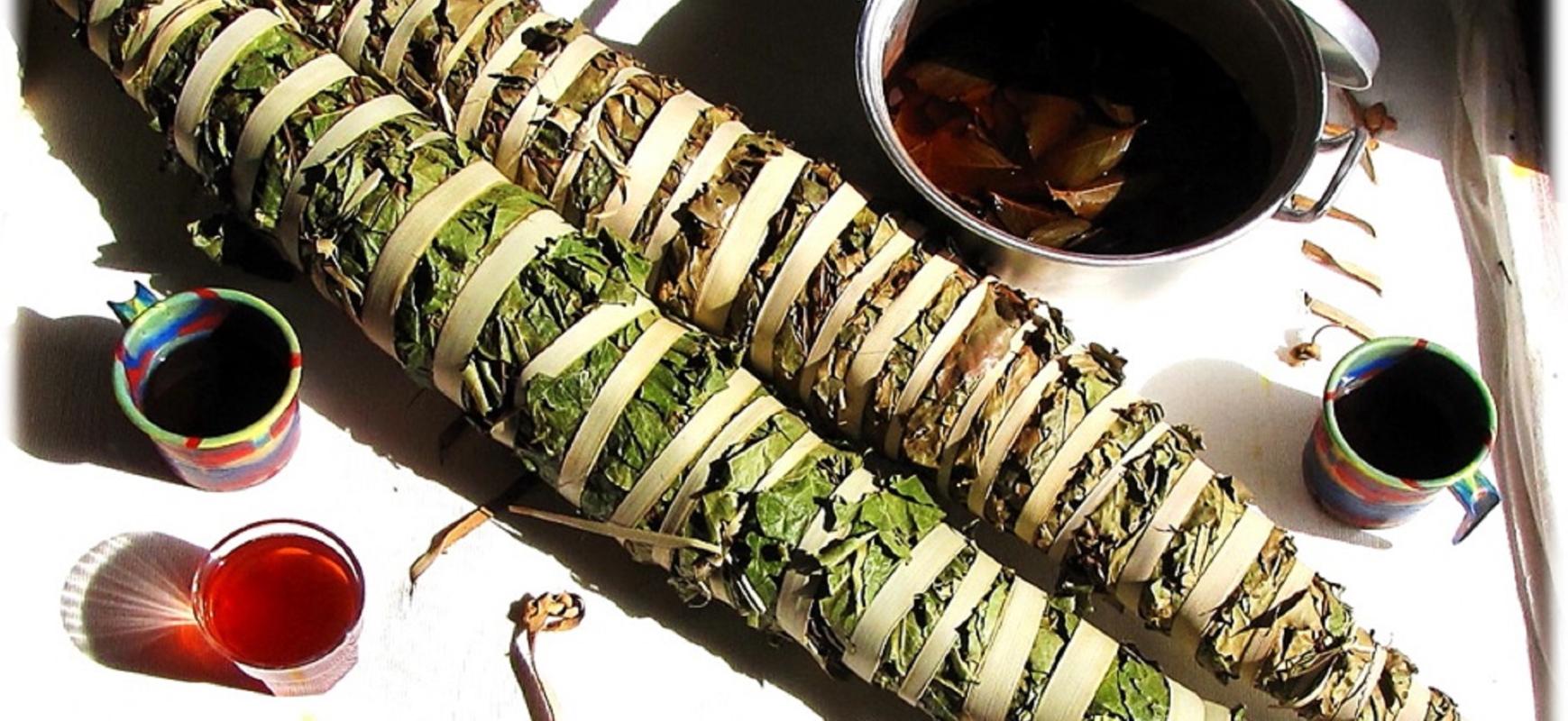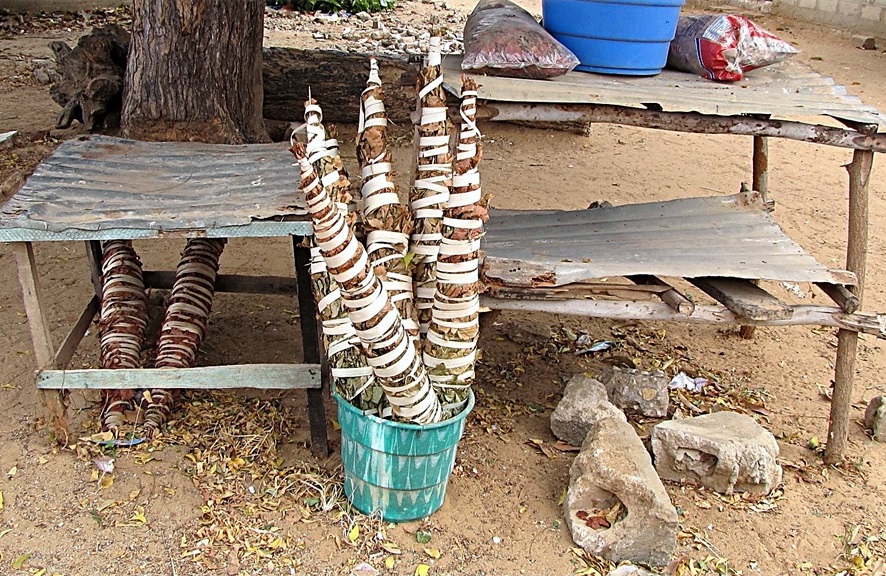
African Medicinal Plants – Part 2
15 Dec 2022
Blog story series written by Ms Mame Diarra Sarr
Exploring the value chain of Kinkeliba
Long-term African development can be achieved through the valorisation of our natural resources. The flora products have substantial potential to accelerate that development. The commercialisation of Kinkeliba (as known as Combretum micranthum) not only improves the social and well-being status of the local people having a stake in the value chain but also is an economically viable activity resulting in solid profits. Its potential expansion at the commercial level is a way to boost economic growth and advance bio-trade revenues in the continent while conserving natural habitats, especially in Senegal, West Africa where there is already a market to supply.
Value chain of Kinkeliba
For the commercialisation of Kinkeliba leaves, a number of actors intervene. They are collectors/suppliers, phytotherapists/traditional healers, retailers, and consumers.
Collectors
Collectors are responsible for the acquisition of the leaves in the harvesting areas and their flow to main markets. Primarily, women between 45 to 70 years old are found in this stage of the value chain. Their role is to either stay on harvesting sites to ensure the supply of certain retailers on-site, or to travel from harvesting areas to marketing areas to supply phytotherapists/ traditional healers and retailers.
The collectors are responsible for the wholesale of the product. They are the first actors in the value chain and are responsible for the drying, sorting, and packaging of Kinkeliba leaves in 50kg bags. We can find three types of collectors in this value chain: those in the harvesting zones (older women), those who travel to the mainstream markets (both men and women), and those that directly supply neighbourhood shops (families living around the harvesting areas).

Phytotherapists/traditional healers
Phytotherapists and healers are mostly men over 50 years old. They source the leaves by purchase from suppliers. They use the Kinkeliba leaves in the making of their own products. With the powerful health benefits and the active ingredients contained in the leaves, Kinkeliba constitutes an important resource in creating healing decoctions and therapeutic powders.
Retailers
Retailers are merchants who identify products from suppliers and resell them to consumers for a profit. They are the most dynamic link in the Kinkeliba value chain because they are found in both harvesting and marketing areas. Both men and women work in this stage of the value chain. They source Kinkeliba leaves mostly by purchase but also through self-supply, which is why some collectors/suppliers in harvesting areas may also be retailers.
Consumers
Consumers represent the most significant actors in the Kinkeliba value chain because the product is well prized in the Senegalese society and consumed at the level of all social strata. Kinkeliba can be accessed either at the market or in neighbourhood shops. Consumers mainly use the leaves for making tea in the morning during breakfast or in the evening with snacks. The actual buying price may vary depending on the localities.
Value chain of Kinkeliba in Senegal, West Africa
Commercialisation of Kinkeliba and its impact on the achievement of Sustainable Development Goals
The enhancement of the commercialisation and utilisation of Kinkeliba leaves can contribute to the achievement of a wide range of Sustainable Development Goals.
|
Goal 1: End poverty in all its forms everywhere Local communities near the harvesting sites are driving income in the bulk commercialisation of Kinkeliba leaves and sustaining family expenses. |
|
|
Goal 2: Zero hunger Kinkeliba is full of rich nutrients which improve nutrition and participate in the betterment of food security in Senegal. Prices are accessible to all income levels. |
|
|
Goal 3: Ensure healthy lives and promote well-being for all at all ages With the discovered glucose-lowering effects, antioxidant and anti-inflammatory activity induced by the intake of Kinkeliba leaves, possible cures for the virulent diseases can be found, therefore, improving the general health of the population. |
|
|
Goal 5: Achieve gender equality and empower all women and girls With women highly active in the value chain of Kinkeliba, inclusivity is present. One interesting fact discovered through research interviews is that older women in the retail stage engage in the commercialisation of Kinkeliba leaves to avoid remaining sedative in their homes and being solely dependent on their families. |
|
|
Goal 8: Promote sustained, inclusive, and sustainable economic growth, full and productive employment, and decent work for all All actors involved in the different stages decently make income from Kinkeliba, which is why people have been in the industry for at least a decade. Given that the industry can still grow substantially, the commercialisation of Kinkeliba leaves can largely contribute to achieving employment. |
|
|
Goal 10: Reduce inequality within and among countries The Kinkeliba value chain and its activities reduces income inequality between people in the city and the ones living in villages. It can further be a factor in reducing inequalities between African countries and economic poles if properly industrialized. |
|
|
Goal 15: Protect, restore, and promote sustainable use of terrestrial ecosystems, sustainably manage forests, combat desertification, halt and reverse land degradation and halt biodiversity loss A number of animals and insects directly depend on the Kinkeliba tree to survive. The tree also plays a vital general role in its habitat by providing microsites which are crucial for the growth of other organisms. |
Conclusion
Kinkeliba leaves, if better utilised and promoted at the commercial level, can potentially become a “super-tea” in the food and beverage industry. Kinkeliba can further be used as a nutraceutical supplement in other products. Pharmaceutical, cosmetics, fitness and weight loss products can also rally the sector.
Kinkeliba tea has more health benefits than other teas available on the national Senegalese market and its preparation is easy and accessible to all levels of income. It can further have a unique value proposition for the expansion of the industry into international markets.
Any expansion strategy should be closely monitored so that the ecological status of the Kinkeliba does not degrade, and habitat conservation is given. The valorisation of this flora product is an example of developing a wildlife economy whereby a stream of sustainable wealth and social impact in local communities can be created coupled with biodiversity conservation.
Mame Diarra Sarr, AWEI Intern 2022
Cover image: Kinkeliba traditional bundles and tea. T.K. Naliaka
Image in text: Kinkeliba bundles sold roadside a few miles outside Dakar, Senegal. T.K. Naliaka
We support the free flow of information. Please share:
More content
-

Leveraging free trade to boost Africa’s wildlife economies through wild-harvested products
Dr Wiseman NdlovuThe intra-Africa trade of wild products presents a unique intersection of economic opportunity and environmental conservation. With the...
2024Research -

Insights from the African Wildlife Economy Colloquium
Klarine SchutteThe inaugural African Wildlife Economy Colloquium, held from 4–6 November at Stellenbosch University, brought together a diverse group…
Articles -

Drivers of hunting and photographic tourism income to communal conservancies in Namibia
Mr Joseph Goergen …Hunting and photographic tourism provide ecosystem services that can facilitate conservation. Understanding factors influencing how tourism industries generate...
2024Research -

SANParks Vision 2040: A New Era for Conservation in South Africa
Ms Emily TaylorReimagining Conservation: SANParks' Vision 2040
South African National Parks (SANParks) has unveiled its ambitious Vision 2040, a…
Articles -

In defence of wild meat’s place at the table
Tim VernimmenQ&A — Conservation scientist E.J. Milner-Gulland
Sustainable and safe consumption of wildlife is possible, and important for those…
Articles -

The diverse socioeconomic contributions of wildlife ranching
Candice Denner…The diverse socioeconomic contributions of wildlife ranching are increasingly recognized as a vital element of sustainable development, particularly...
2024Research -

A conflict of visions: Ideas shaping wildlife trade policy toward African megafauna
Mr Michael 't Sas-Rolfes…The issue of wildlife trade is a major concern for the conservation of African megafauna, such as elephants...
2024Research -

Barriers to the Participation of the Traditional Leadership Institution in Promoting Rural Agricultural Development
Dr Wiseman Ndlovu…The Traditional Leadership Institution (TLI) is constitutionally recognised to promote rural development in South Africa. It works with...
2022Research -

Elephant in the Room - Why a trophy hunting ban would hurt conservation and development
Dr Francis Vorhies“Trophy hunting, if well managed, conserves wild species and habitats and enhances livelihoods in rural communities.” - Dr...
2024Briefs
Get updates by email
Through impactful research, stakeholder engagement, and professional development, AWEI is supporting the wildlife economy across Africa. Please subscribe for occasional updates on our work and forthcoming events.
Sign up for a quarterly dose of AWEI insights
In a complex and changing world, AWEI generates strategic ideas, conducts independent analysis on wildlife economies, and collaborates with global scholar-practitioners to provide training and expertise for biodiversity conservation, climate resilience, and inclusive economic opportunities in Africa.
